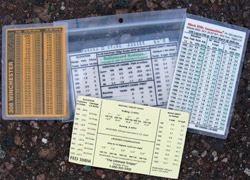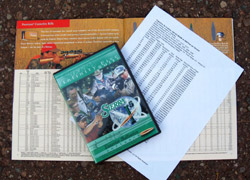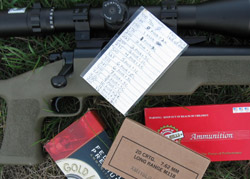Shooting Tips
Ballistic Data Cards
Years ago I coined the axiom, "You cannot shoot more precisely than you can aim," to underline the importance of a crisply focused reticle, properly set elevation and correct sight picture. The essence of precision shooting is applying such factors consistently, shot after shot.
Another of my shooting axioms, which I'll be covering here today, is that, "You must know where your bullet should strike, to get it to strike there." To achieve true precision, you need to determine the exact trajectory of YOUR load when fired through YOUR rifle using YOUR target knob-equipped scope. This trajectory data will yield a Ballistic Data Card unique to your rifle and to your specific load, enabling you to know exactly where your round will impact.
 A variety of commercial ballistic data cards exist, but they don't contain target knob settings, and won't be as precise as the one you make yourself.
A variety of commercial ballistic data cards exist, but they don't contain target knob settings, and won't be as precise as the one you make yourself.Step One: The "Book" Ballistic Data
Our starting point is what I call "book" ballistics. You can find your specific round's trajectory data in the cartridge manufacturer's brochures, on their company website, or you can generate it yourself using ballistic software, such as Sierra's Infinity program. This trajectory data (also called, "bullet path") traces how much your bullet falls after the zero distance, which usually is 100 yards.
I solved that problem long ago by apportioning the amount a bullet drops between those 100-yard distances, at 25-yard increments. Since a bullet's trajectory is a curve that becomes steeper with distance, this rate-of-drop is minimal at the first 25 yards, more at the second 25 yards, and greatest at the third 25 yards. (The fourth 25 yards, of course, puts you at the next 100-yard-distance.)
Here's my rule-of-thumb, which works very well no matter the range: For the first 25 yards, apply 25% of the difference; at 50 yards, calculate 45% of the difference, and at 75 yards, use 75% of the difference. Let's look at one example. For the .308 Winchester, 168-gr. Match load, the drop at 700 yards is -162.58 inches, and at 800 yards it's -237.19 inches. Thus the difference is 74.61 inches. We simply need to apportion those 74.61 inches of drop at 725, 750 and 775 yards. Using my rule-of-thumb, the 25% drop is -177.5 inches at 725 yards, very close to the actual drop of -179.4 inches; the 45% drop is -196.15 inches at 750 yards, again close to the actual drop of -197.4 inches; and the 75% drop is -218.53 inches, almost exactly the actual drop of 216.64 inches. It's simple and accurate.
 Begin by finding your load's Ôbook' ballistic data in the ammo maker's brochure, on a company website, or through ballistic software.
Begin by finding your load's Ôbook' ballistic data in the ammo maker's brochure, on a company website, or through ballistic software.Step Two: Converting Ballistic Data into Target Knob Settings
In the table below I've converted the .308 Winchester, 168-gr. Match load's trajectory ("bullet path") -- first into Minutes of Angle elevation, and then, into target knob settings for knobs having either 1/4 Minute-of-Angle per click, or 1/8 Minute-of-Angle per click. To help you see how these knob increments differ, I'm listing the MOA equivalents per click on both 1/4 and 1/8 MOA knobs. (For details about Minutes of Angle, see my earlier article, "Mastering Your Target Knobs.")
| 1/4 MOA Target Knob | 1/8 MOA Target Knob |
|---|---|
| 1 click = 0.25 MOA | 1 click = 0.125 MOA |
| 2 clicks = 0.50 MOA | 2 clicks = 0.250 MOA |
| 3 clicks = 0.75 MOA | 3 clicks = 0.375 MOA |
| 4 clicks = 1.00 MOA | 4 clicks = 0.500 MOA |
| 5 clicks = 0.625 MOA | |
| 6 clicks = 0.750 MOA | |
| 7 clicks = 0.875 MOA | |
| 8 clicks = 1.000 MOA |
First, we must convert your "bullet path" trajectory data into MOAs, which only requires that you divide the amount of drop by the distance in hundreds of yards. Looking at the table below, at 250 yards you divide the -8.91 inches of drop by 2.5 (the 250-yard distance in hundreds of yards), to find that it equals 3.56 Minutes of Angle. Finally, to apply this to your target knob, simply round off the 3.56 for a 1/4 MOA target knob — it's very close to 3-1/2 Minutes, so I recorded it as, "3 M" (meaning 3 MOA), plus "2 c" (which stands for two clicks.) In the case of a 1/8 MOA knob it's the same rounding off process, but the finer increments allow more precision.
.308 Winchester, 168-grain BTHP Match
[100-Yard Zero] |
|||||
|---|---|---|---|---|---|
| Range/Yards | Bullet Path | MOA Elev | 1/4 Tgt Knob | 1/8 Tgt Knob | |
| 100 | 0.00" | divide by 1.00 | 0 | 0 M / 0 c | 0 M / 0 c |
| 125 | -0.46" | divide by 1.25 | 0.36 | 0 M / 1 c | 0 M / 3 c |
| 150 | -1.31" | divide by 1.50 | 0.87 | 1 M / 0 c | 0 M / 7 c |
| 175 | -2.57" | divide by 1.75 | 1.46 | 1 M / 2 c | 1 M / 4 c |
| 200 | -4.24" | divide by 2.00 | 2.12 | 2 M / 0 c | 2 M / 1 c |
| 225 | -6.35" | divide by 2.25 | 2.82 | 2 M / 3 c | 2 M / 6 c |
| 250 | -8.91" | divide by 2.50 | 3.56 | 3 M / 2 c | 3 M / 4 c |
| 275 | -11.94" | divide by 2.75 | 4.34 | 4 M / 1 c | 4 M / 3 c |
| 300 | -15.47" | divide by 3.00 | 5.15 | 5 M / 1 c | 5 M / 1 c |
| 325 | -19.51" | divide by 3.25 | 6 | 6 M / 0 c | 6 M / 0 c |
| 350 | -24.09" | divide by 3.50 | 6.85 | 7 M / 0 c | 6 M / 7 c |
| 375 | -29.24" | divide by 3.75 | 7.79 | 7 M / 3 c | 7 M / 6 c |
| 400 | -34.97" | divide by 4.00 | 8.74 | 8 M / 3 c | 8 M / 6 c |
| 425 | -41.33" | divide by 4.25 | 9.72 | 9 M / 3 c | 9 M / 6 c |
| 450 | -48.34" | divide by 4.50 | 10.74 | 10 M / 3 c | 10 M / 6 c |
| 475 | -56.04" | divide by 4.75 | 11.79 | 11 M / 3 c | 11 M / 6 c |
| 500 | -64.46" | divide by 5.00 | 12.89 | 13 M / 0 c | 12 M / 7 c |
| 525 | -73.63" | divide by 5.25 | 14.02 | 14 M / 0 c | 14 M / 0 c |
| 550 | -83.60" | divide by 5.50 | 15.2 | 15 M / 1 c | 15 M / 2 c |
| 575 | -94.41" | divide by 5.75 | 16.41 | 16 M / 2 c | 16 M / 3 c |
| 600 | -106.10" | divide by 6.00 | 17.68 | 17 M / 3 c | 17 M / 6 c |
| 625 | -118.71" | divide by 6.25 | 18.99 | 19 M / 0 c | 19 M / 0 c |
| 650 | -132.29" | divide by 6.50 | 20.35 | 20 M / 1 c | 20 M / 3 c |
| 675 | -146.90" | divide by 6.75 | 21.76 | 21 M / 3 c | 21 M / 6 c |
| 700 | -162.58" | divide by 7.00 | 23.22 | 23 M / 1 c | 23 M / 2 c |
| 725 | -179.40" | divide by 7.25 | 24.74 | 24 M / 3 c | 23 M / 6 c |
| 750 | -197.40" | divide by 7.50 | 26.32 | 26 M / 1 c | 24 M / 2 c |
| 775 | -216.64" | divide by 7.75 | 27.95 | 28 M / 0 c | 28 M / 0 c |
| 800 | -237.19" | divide by 8.00 | 29.64 | 29 M / 3 c | 29 M / 5 c |
| 825 | -259.11" | divide by 8.25 | 31.4 | 31 M / 2 c | 31 M / 3 c |
| 850 | -282.46" | divide by 8.50 | 33.23 | 33 M / 1 c | 33 M / 2 c |
| 875 | -307.30" | divide by 8.75 | 35.12 | 35 M / 0 c | 35 M / 1 c |
| 900 | -333.71" | divide by 9.00 | 37.07 | 37 M / 0 c | 37 M / 1 c |
| 925 | -361.74" | divide by 9.25 | 39.1 | 39 M / 1 c | 39 M / 2 c |
| 950 | -391.46" | divide by 9.50 | 41.2 | 41 M / 1 c | 41 M / 2 c |
| 975 | -422.93" | divide by 9.75 | 43.37 | 43 M / 1 c | 43 M / 3 c |
| 1000 | -456.22" | divide by 10.00 | 45.62 | 45 M / 2 c | 45 M / 5 c |
At each yardage I inserted how to divide the bullet path so you could clearly see how I divided using the distance in hundreds of yards -- such as, at 825 yards you divide by 8.25 (the distance in hundreds of yards) to learn that you must set a 1/4 MOA elevation knob at 31 Minutes plus 2 clicks, and a 1/8 MOA elevation knob at 31 Minutes plus 3 clicks. Why the difference? The finer 1/8 MOA increments allows me to set that knob at 31 Minutes plus .375 (3 clicks) which is closer to the true elevation (31.40 MOA) than a 1/4 MOA knob's 31 Minutes plus .50 (2 clicks).
Use this process to convert bullet path data into target knob settings for any load and any trajectory.
Step Three: Preparing Your Ballistic Data Card
You now have all the data and knob elevation settings you need — now we'll put this into a usable format that you can carry in the field. Simply list the data on a 3 x 5 card using the 1/4 MOA data if your target knobs use 1/4 MOA increments, such as the Millett Long Range Scope (LRS), or use the 1/8 MOA data for a scope having 1/8 MOA increments, for scopes like the Millett Tactical Rifle Scope (TRS).
There is, however, one critical nuance: You must take into account the amount of MOAs you have per rotation on your target knob. Many scopes, including the Millett LRS, have 15 Minutes of Angle per target knob rotation; others, such as the Millett TRS, have 8 Minutes of Angle. Since your card lists knob settings well BEYOND a single rotation, you must distinguish which settings are on the first rotation, which are on the second rotation, then on the third, and finally, (see below), the 1000-yard target knob setting on the fourth rotation.
Here's how I do it for my LRS scope, which is mounted on a .308 rifle. All the way to 525 yards, the elevation settings are on the first rotation, as listed in the left column. At 550 yards, it reads, "15 MOA / 1 c," which means I've just now gone BEYOND the first rotation. So, knowing I'm now into the second rotation, I start another column to the right, and rewrite that knob setting as "0 MOA / 1 c". It's the same elevation — except my knob is now starting its next rotation. Study the following table for a moment.
.308 Winchester, 168-grain BTHP Match Data
| Range/Yards | 1/4 MOA | |||
|---|---|---|---|---|
| 100 | 0 M / 0 c | |||
| 125 | 0 M / 1 c | |||
| 150 | 1 M / 0 c | |||
| 175 | 1 M / 2 c | |||
| 200 | 2 M / 0 c | |||
| 225 | 2 M / 3 c | |||
| 250 | 3 M / 2 c | |||
| 275 | 4 M / 1 c | |||
| 300 | 5 M / 1 c | |||
| 325 | 6 M / 0 c | |||
| 350 | 7 M / 0 c | |||
| 375 | 7 M / 3 c | |||
| 400 | 8 M / 3 c | |||
| 425 | 9 M / 3 c | |||
| 450 | 10 M / 3 c | |||
| 475 | 11 M / 3 c | |||
| 500 | 13 M / 0 c | |||
| 525 | 14 M / 0 c | Next Rotation | ||
| 550 | 15 M / 1 c | 0 M / 1 c | ||
| 575 | 16 M / 2 c | 1 M / 2 c | ||
| 600 | 17 M / 3 c | 2 M / 3 c | ||
| 625 | 19 M / 0 c | 4 M / 0 c | ||
| 650 | 20 M / 1 c | 5 M / 1 c | ||
| 675 | 21 M / 3 c | 6 M / 3 c | ||
| 700 | 23 M / 1 c | 8 M / 1 c | ||
| 725 | 24 M / 3 c | 9 M / 3 c | ||
| 750 | 26 M / 1 c | 11 M / 1 c | ||
| 775 | 28 M / 0 c | 13 M / 0 c | ||
| 800 | 29 M / 3 c | 14 M / 3 c | Next Rotation | |
| 825 | 31 M / 2 c | 1 M / 2 c | ||
| 850 | 33 M / 1 c | 3 M / 1 c | ||
| 875 | 35 M / 0 c | 5 M / 0 c | ||
| 900 | 37 M / 0 c | 7 M / 0 c | ||
| 925 | 39 M / 1 c | 9 M / 1 c | ||
| 950 | 41 M / 1 c | 11 M / 1 c | ||
| 975 | 43 M / 1 c | 13 M / 1 c | Next Rotation | |
| 1000 | 45 M / 2 c | 0 M / 2 c |
Having examined the table, I think you'll see that we do the same thing at 825 yards — we're now into the third rotation, so I've re-expressed the "31 M / 2 c" for a new rotation, making it, "1 M / 2 c". And finally, we do the same thing at 1000 yards, where we've now crossed into the fourth rotation.
Put all this on a 3 x 5 card. I usually put 500 yards on each side so my writing isn't so small that it's difficult to read. Then I cover it with clear, wide tape, and I'm ready to go.
 Your finished card contains precise elevation settings at 25-yard increments to maximum range, for unparalleled accuracy.
Your finished card contains precise elevation settings at 25-yard increments to maximum range, for unparalleled accuracy.The Final Step — Confirmation Firing
You have now prepared a precise ballistic data card, containing all your target knob settings. This is excellent but it's also THEORETICAL. The ballistic software that generates trajectory data is driven by certain standards, prepared by SAAMI, the Sporting Arms and Ammunition Manufacturer's Institute. These assume: a rifle having a 24-inch barrel; a scope mounted 1-1/2 inches above the bore; a shot fired in an ambient temperature of 59 degrees Fahrenheit; and, fired at sea level. To the degree that your rifle and scope and shooting environment differ from these standards, you will experience slightly different results.
